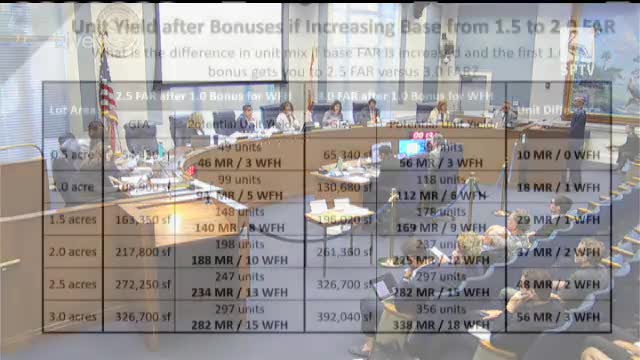City Council Debates Bold Housing and Parking Reforms
September 05, 2024 | St. Petersburg, Pinellas County, Florida
This article was created by AI summarizing key points discussed. AI makes mistakes, so for full details and context, please refer to the video of the full meeting. Please report any errors so we can fix them. Report an error »

During a recent city council meeting, discussions centered on proposed changes to the Floor Area Ratio (FAR) and the implications for workforce housing, parking regulations, and food truck operations in the area. Council members debated the potential benefits of increasing the FAR to 2.0 while also considering a workforce housing density bonus. The council emphasized the importance of allowing the market to dictate parking needs, particularly in transit-oriented developments, where residents have expressed a preference for less parking and more housing options.
Council Member Driscoll highlighted the success of recent developments that have adopted no minimum parking requirements, suggesting that this approach could help lower housing costs by reallocating space typically reserved for parking to residential units. The council discussed the need for flexibility in parking regulations, arguing that developers should be empowered to determine the appropriate amount of parking based on their projects.
The conversation also touched on the role of food trucks in the community. Some council members questioned existing restrictions that limit food trucks to operating only a few days per week, arguing that these limitations could hinder small business owners. The administration defended the regulations, citing concerns that allowing food trucks to operate full-time could undermine the requirement for ground-floor commercial space in new developments.
Additionally, the council reviewed an environmental report related to future industrial uses, with some members expressing concerns that vague language could stifle development. Council Member Gabbard proposed aligning the language in the ordinance with existing regulations to ensure consistency and avoid unnecessary barriers for developers seeking financing.
The meeting concluded with a unanimous vote to approve an amendment related to the environmental report, indicating a collaborative effort among council members to refine the proposed regulations while addressing community needs and concerns. Further discussions are expected as the council continues to navigate the complexities of urban development and community engagement.
Council Member Driscoll highlighted the success of recent developments that have adopted no minimum parking requirements, suggesting that this approach could help lower housing costs by reallocating space typically reserved for parking to residential units. The council discussed the need for flexibility in parking regulations, arguing that developers should be empowered to determine the appropriate amount of parking based on their projects.
The conversation also touched on the role of food trucks in the community. Some council members questioned existing restrictions that limit food trucks to operating only a few days per week, arguing that these limitations could hinder small business owners. The administration defended the regulations, citing concerns that allowing food trucks to operate full-time could undermine the requirement for ground-floor commercial space in new developments.
Additionally, the council reviewed an environmental report related to future industrial uses, with some members expressing concerns that vague language could stifle development. Council Member Gabbard proposed aligning the language in the ordinance with existing regulations to ensure consistency and avoid unnecessary barriers for developers seeking financing.
The meeting concluded with a unanimous vote to approve an amendment related to the environmental report, indicating a collaborative effort among council members to refine the proposed regulations while addressing community needs and concerns. Further discussions are expected as the council continues to navigate the complexities of urban development and community engagement.
View full meeting
This article is based on a recent meeting—watch the full video and explore the complete transcript for deeper insights into the discussion.
View full meeting